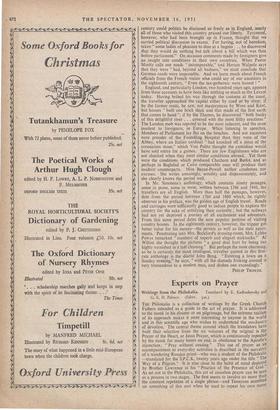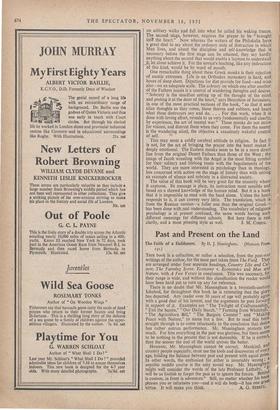Experts on Prayer
Writings from the Philokalia. Translated by E. Kadloubovsky and
G. E. H. Palmer. (Faber. 3os.)
THE Philokalia is a collection of writings by the Greek Church Fathers intended as a guide to the art of prayer. It is addressed to the monk in his cloister or on pilgrimage, but the extreme realism of its approach makes it most interesting to anyone in the world and in this scientific age who wishes fo understand the mechanics of devotion. The central theme around which the translators have built their selection from the six volumes of the original is the Prayer of the Heart, or Jesus Prayer, which is cbritinuously repeated by the monk for many hours on end, in obedience to the Apostles injunction: "Pray without ceasing." This use of prayer as an accompaniment to every-day activities is described in the narrative of a wandering Russian priest—who was a student of the Philokalia —translated for the S.P.C.K. twenty years ago under the title "Tile Way of a Pilgrim." It is also close to the habit of mind depicted by Brother Lawrence in his "Practice of the Presence of God." As set out in the Philokalia, this art of ceaseless prayer can be seen as a process in two stages. The first seems to involve no more than the constant repetition of a single phrase—and Tennyson stumbled on something of this sort when he used to repeat his own name
on solitary walks and fall into what he called his waking trance. The second stage, however, requires the prayer to be "brought into the heart." Now whereas the writers of the Philokalia have a great deal to say about the ordinary state of distraction in which Man lives, and about the discipline and self-knowledge that is necessary before the first stage can be attained, they say hardly anything about the second that would enable a layman to understand _it, let alone achieve it. For the novice's teaching, like any instruction of this kind, would be by word of mouth.
One remarkable thing about these Greek monks is their rejection of ascetic extremes. Life in an Orthodox monastery is hard, and hours of sleep short. Directions for diet provide for food—and wine also—on an adequate scale. The sobriety on which one after another of the Fathers insists is a control of wandering thoughts and desires. "Sobriety is the steadfast setting up of the thought of the mind and posting it at the door of the heart," says Hesychius of Jerusalem, in one of the most practical sections of the book, "so that it sees alien thoughts as they come, those thieves and robbers, and hears what these destroyers say and do. . . . For this work, when it is done with loving effort, reveals to us very fundamentally and clearly, by experience, the art of mental war." These monks do not strive for visions, and distrust them when they come. For them the enemy is the wandering mind, the objective a ceaselessly wakeful control of self.
This may seem a coldly cerebral attitude to religion. In fact it is not, for the act of bringing the prayer into the heart makes it deeply emotional. The Eastern monks seem to be in a more direct line from the original Desert Fathers than those of the West ; the image of Jacob wrestling with the Angel is the most fitting symbol for their solitary and lifelong tussle with the beguilements of the world. They are more interested in psychology than in theology, less concerned with action on the stage of history than with setting an example of silence and sobriety in a distracted society. The value of this book will be very great for the minority whom it captures. Its message is plain, its instruction most sensible and based on a shrewd knowledge of the human mind. But it is a book that it is impossible to read with the head alone. Unless the heart responds to it, it can convey very little. The translation, which is from the Russian version—a fuller one than the original Greek— has been done with real understanding. The vocabulary of religious psychology is at present confused, the same words having such different meanings for different schools. But here there is real clarity, and a most pleasing style as well. J. M. COHEN.















































































 Previous page
Previous page